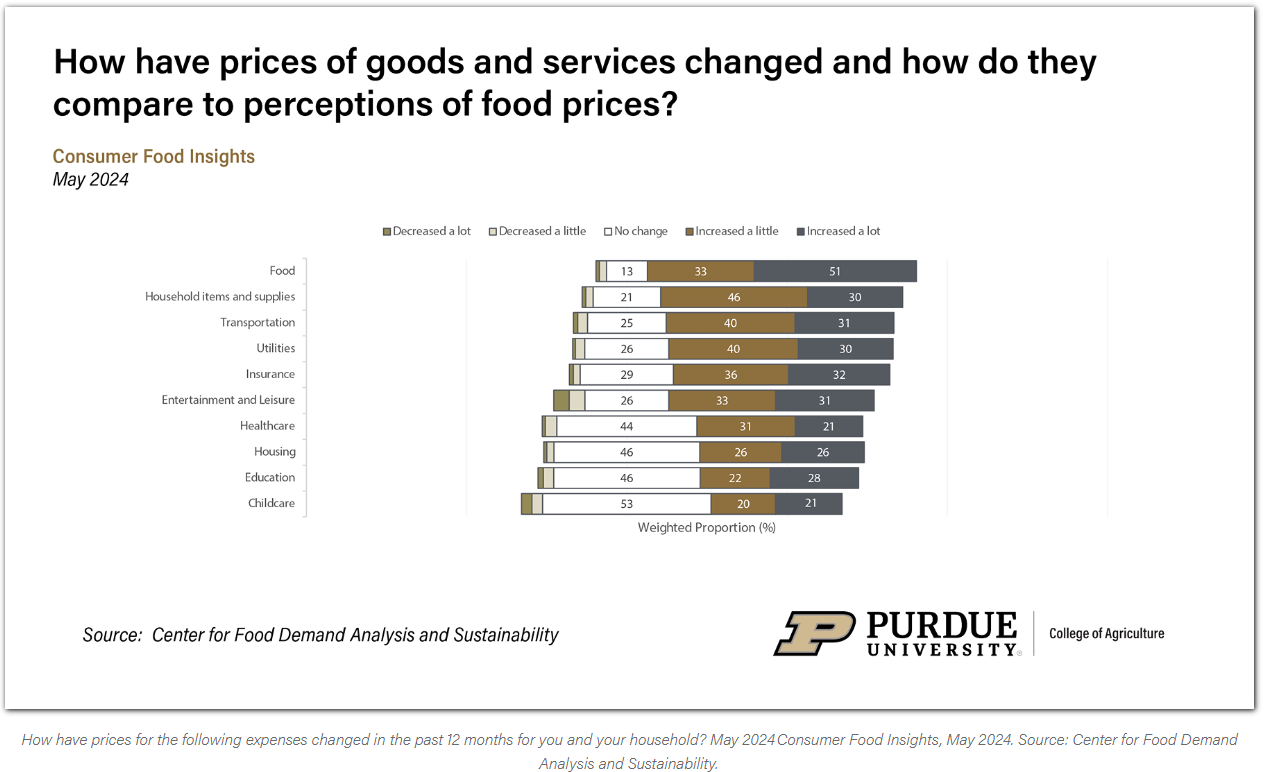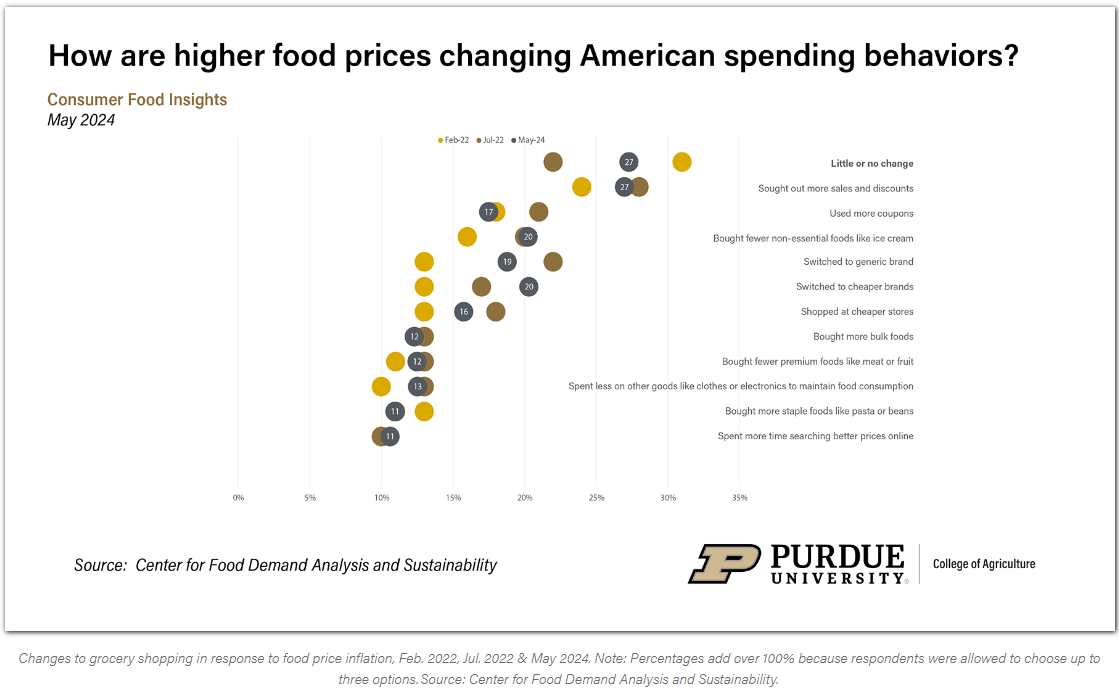



Consumers see food prices as rising more than other goods and services, find ways to adapt
Consumers are seeking out sales and discounts, switching to cheaper and generic brands and buying fewer nonessential foods like ice creamMore than 80% of consumers perceive that food prices have increased a little or a lot over the last 12 months, according to the May 2024 Consumer Food Insights Report (CFI).
The survey-based report out of Purdue University’s Center for Food Demand Analysis and Sustainability assesses food spending, consumer satisfaction and values, support of agricultural and food policies and trust in information sources. Purdue experts conducted and evaluated the survey, which included 1,200 consumers across the U.S.
The Bureau of Labor Statistics’ consumer price index measure of food inflation shows a 12-month increase in food prices of 2.2%, down from 4.4% a year ago. “While food inflation has slowed in 2024, consumers are feeling the cumulative effect of the high inflation we’ve experienced,” said the report’s lead author, Joseph Balagtas, professor of agricultural economics at Purdue and director of CFDAS.

The May CFI survey asked consumers to report their experiences and responses to rising food prices over the last 12 months. The survey included a question asked previously in February and July 2022, seeing how consumers have adapted their grocery shopping in response to food price inflation.
The researchers found that the most common shopping adaptations to food inflation are seeking out sales and discounts, switching to cheaper and generic brands, and buying fewer nonessential foods like ice cream.
“We also wanted to understand how perceived changes in food prices compare with perceived price changes for other common household expenses,” Balagtas said. “Consumers were more likely to report price increases for food than for any other good or service in the economy.”
Similarly, when asked which goods and services saw the largest year-over-year price increase, 56% of consumers selected “food,” despite official inflation data that show prices of insurance, housing and child care have risen faster than prices for food in the past year. “It’s possible the high frequency with which we shop for food could make higher food prices more salient to consumers. Media attention to food could also play a role,” Balagtas said.
The May survey revisited generational differences analyzed in past reports by categorizing consumers into Gen Z (born after 1996), millennials (born 1981-1996), Gen X (born 1965-1980), and boomer-plus (born before 1965).
“One area where we see bigger generational differences when asking about recent consumer experiences is the source of funding that consumers reported relying on to purchase food,”
Balagtas said. “Around 37% of Gen Z and millennial consumers report drawing on savings or going into debt to finance their food purchases over the past year compared to 28% of Gen X and only 13% of boomer-plus consumers. It is concerning to see over a third of young adults needing to stretch their finances to afford food.”
Food insecurity is highest among Gen Z adults, with around one-third of consumers from this group also reporting having trouble accessing quality food. This is much higher than the rate of food insecurity among older Gen X (13%), and boomer-plus (5%) consumers.
“More research is needed, but these results are likely driven in part by a stage-of-life effect, as income and wealth increase are drivers of food security and tend to increase with age,” Balagtas said.
The April consumer price index measure of food price inflation — the most recent available — remained unchanged from March at 2.2%. The inflation rate seems to have stabilized, having stayed around 2.2% for the last three months, noted Elijah Bryant, a survey research analyst at CFDAS and co-author of the report.
“According to the center’s data, consumer estimates of food inflation over the past year of 6.2% and expectations for the coming year of 3.6% continue to remain higher than the CPI estimate,” Bryant said. This suggests that consumer experiences with food prices have been different than the official measurement.
“Consumers’ inflation estimates continue to hover around 6%, showing that the dramatic increase in food inflation in previous years may still be affecting consumer food price sentiment. However, consumers have been consistently more optimistic about future food prices relative to their inflation estimates over the past 12 months,” Bryant said.
Consumers are asked to allocate 100 points among the six attributes — taste, affordability, nutrition, availability, environmental impact and social responsibility — based on the importance of each in their grocery purchasing decisions. Though CFDAS began measuring food values on a quarterly basis in January 2024, the researchers have yet to observe significant changes in the importance level of these attributes.

“Taste, affordability and nutrition continue to be heavily considered by consumers when making a purchasing decision at the grocery store, whereas environmental impact and social responsibility are of lower importance,” Bryant said. “Americans’ values have proven to be fairly consistent despite changes to the economic landscape over the past couple of years.”
The survey results show generational differences in food values, too, between the younger Gen Z and millennial groups and the oldest boomer-plus group. Younger generations place more value on the environmental and social responsibility of their food when choosing what to buy. Older consumers are more concerned about taste.
The frequency of certain shopping and eating habits also differs across age groups. For instance, younger consumers are more likely to choose nonconventional foods compared to older consumers.
“We see this with organic foods, grass-fed beef, cage-free eggs and plant-based proteins,” Bryant said. However, all consumers regardless of age report checking food date labels often.
“We also observe older consumers report eating unwashed produce, raw dough and rare meat less frequently than younger consumers,” he said. This aligns with differences seen in risk attitudes among consumers of different ages. “Young adults are more willing to take risks with their food than older adults,” Bryant said.


